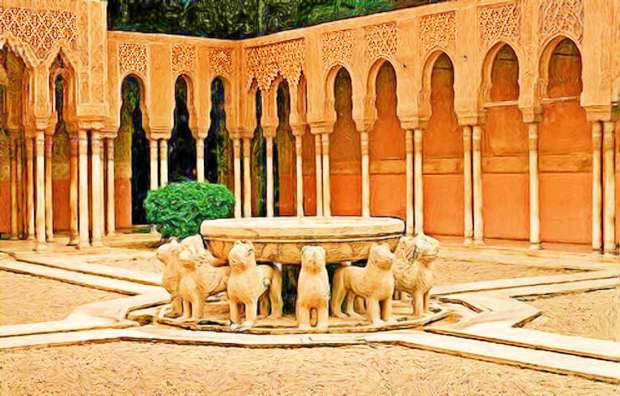A palace-fortress concealing an interior of unsurpassed beauty, the Alhambra recalls Spain’s Islamic past. It sits high above an ancient city, framed against the spectacular backdrop of the Sierra Nevada’s shimmering snow-capped peaks. The ancient palace of the Moorish rulers of Spain dominates the modern city of Granada just as its builders once dominated their extensive empire.
A glowing red citadel, the Alhambra includes a maze of perfectly proportioned shady courtyards, filigreed galleries, sunlit palaces and arcades. The Moors were Muslims from North Africa who invaded Spain in the early eight century AD. During the ninth century, they built a fortress on the remains of Alcazaba, an ancient stronghold. From the 12th to the 14th centuries, the Moorish kingdom was attacked again and again by Christian armies. The Christian took the city of Cordoba in the 13th century and thousands of Moorish refugees fled to Grenada.
Their shrinking kingdom now centred on Grenada, the Moors at once strengthened the Alcazaba’s fortifications with an enclosing wall, towers and ramparts, and built canals and new aqueducts to improve the water supply. The restructured building was eventually called the Red Fort, or Al-Qal’a al-Hambra in Arabic – the origin of the modern Spanish name Alhambra. But the Alhambra’s lasting fame derives less from its strength as a military fortress than from the beauty and originality of its interiors, the legacy of King Yusuf I (1333-54) and King Mohammed V (1354-91). While the exterior of this bastion is somewhat austere, the courtyards and halls that lie within are uniquely imaginative in their conception, ranging in style from elegantly understated to overtly theatrical. Descended from a desert race, the Moors had a deep fascination with water and incorporated it imaginatively into their architectural structures at every opportunity. They created restful, mirror-surfaced pools to reflect the beautifully proportioned arches and galleries, and fountains with tinkling rivulets of water to provide visual refreshment in the scorching heat of the day.

Masters in the exploitation of space and light, the architects of the Alhambra designed marble-lined pools and floors that would reflect fragments of the bright Andalusian sunlight, bathing the palace courts in an ever-shifting golden radiance. They built graceful arches and galleries to capture the cooling breezes and the echo of rustling leaves, and grand courtyards that led into shady, colonnaded arcades which opened out onto majestic terraces. The Alhambra’s most dramatic architectural achievement is the rich stalactite ornamentation – an art form unique to Islam – in domes, niches and on arches, which creates the effect of a honeycomb composed of thousands of cells filled with natural light and shadow. This decorative device seems to soak up light reflected from adjacent surfaces and then, as in the ceiling of the Hall of the Two Sisters, explode with vibrant energy. The ceiling of the Hall of Abencerrajes is similar in conception. Reached by a doorway from the Court of Lions, the hall is named after a noble family of Granada believed to have been massacred here in the late 15th century. The eye is drawn irresistibly to the detailed intricacies of the ceiling’s profusion of stalactites.

Every court and every corner of the Alhambra complex bears a distinctive feature, each one more enchanting than the last. The Court of Myrtles is lined with two long myrtle hedges that border the gleaming marble paths on either side of the central pool. Its still water, like a sheet of glass, reflects the slim columns of the arcades and goldfish weave flashes of gold through its crystal-clear waters. The Tower of Comares, which rises at one end of the pool, tops the Hall of Ambassadors, the largest room in the palace with a coffered ceiling of carved cedar 60ft (18m) high. Here, foreign dignitaries came to pay their respects to the king, enthroned in a recess opposite the entrance.

The Court of Lions is named after the 12 marble lions that support the central fountain. From the mouth of each lion a stream of water pours forth into the circular channel surrounding the fountain. The channel is fed by four waterways, cut into the stone paving, which lead from the shallow basins of fountains situated in adjacent rooms. A total of 124 columns support the arcades around the court, while pavilions on the western and eastern sides of the court provide vantage points from which to view the water cascading from the lions’ mouths.

The Alhambra was finally surrendered to the Christians in 1492. In 1526, as if to confirm Christian supremacy in Spain, King Charles V of Spain rebuilt sectors of the Alhambra in the Renaissance style and began to build his own Italianate palace inside the fortress walls. But work on the new palace was never completed, and the Moorish achievement at Granada – the most splendid surviving example in Spain of their genius – remains unchallenged. An unsurpassed fairytale world of filigree the Alhambra might have been built so that the Moors could possess their own Paradise on Earth.



































